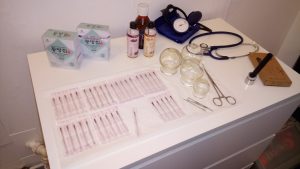


ACUPUNCTURE SAFETY
Acupuncture safety is a very important issue both for patients and practitioners. It is advisable, therefore, to only ever have traditional acupuncture from a practitioner who is a member of the British Acupuncture Council (BAcC). Sadly, despite protracted legal and political wrangling, the term acupuncturist is not legally-protected in the same way that some professions are. As long as you always chose a BAcC member, you will know that you will be receiving treatment from a practitioner who adheres to the most stringent acupuncture safety standards.

All equipment must adhere to acupuncture safety standards as set up by the BAcC
Acupuncture has been practised for at least four thousand years, and concepts of safety have naturally evolved over this time. The code of safe practice published by the BAcC for its members is the document that is used in the UK today to ensure acupuncture safety is always extremely high. Areas this covers include:
-
Hand-washing with anti-bacterial soap immediately before and after insertion of acupuncture needles
-
Only disposable paper towels to be used for drying hands after washing
-
Disposable couch roll to be used for each patient
-
Use of authorised disposable single-use needles only from producers with accreditation for supplying needles within the EU
-
All needles used come from individual sterile packets and are opened immediately prior to treatment
-
Safe and hygienic removal of used needles and medical waste by authorised couriers
-
Cleanliness of all work surfaces in the treatment room
-
Clothing and any jewellery worn by the practitioner must not be loose or dangling
-
The practitioner must inform their own GP immediately if they suspect they may have a notifiable infectious disease or if they have been in contact with somebody suffering from one
- These standards extend to all adjunctive therapies practised by acupuncturists, such as cupping. For more specific information about cupping, go to: http://www.londonacupuncturetherapy.co.uk/cupping/
The acupuncture safety standards imposed are so high that it even extends to the flooring in the treatment room! Floors are required to be smooth and impervious. If carpeting is used, it must be short pile (not looped) commercial carpeting. This specific regulation is in the case of a needle being inadvertently dropped to make sure it can be seen easily.
These safety standards, most of which are referred to under the term Clean Needle Technique, are designed to provide protection against all-known microbiological cross-infection, including HIV and hepatitis. The safe practice code provides a safe treatment environment for both practitioner and public. Any failure to adhere to these acupuncture safety guidelines are treated as a breach of the BAcC’s Code of Professional Practice and are treated with great seriousness, with financial penalties and expulsion from the organisation as part of the possible censure.
As a practitioner, I welcome the stringent nature of the BAcC codes, which ensure acupuncture safety for all patients and members of the public. Occasionally, I might hear a colleague grumble about the painstaking nature of some of the regulations, but in the end we all realise how important following these guidelines are.
If you wish to carry out further research on acupuncture safety, please go to:
http://www.nhs.uk/Conditions/Acupuncture/Pages/Introduction.aspx


